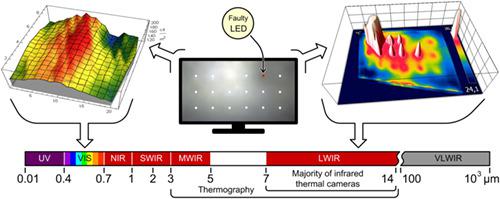当前位置:
X-MOL 学术
›
J. Soc. Inf. Disp.
›
论文详情
Our official English website, www.x-mol.net, welcomes your
feedback! (Note: you will need to create a separate account there.)
Infrared thermography as evaluation method of a faulty status of a LED LCD TV
Journal of the Society for Information Display ( IF 1.7 ) Pub Date : 2020-07-09 , DOI: 10.1002/jsid.951 Hrvoje Glavaš 1 , Tomislav Barić 1 , Dina Jukić 1 , Eleonora Desnica 2
Journal of the Society for Information Display ( IF 1.7 ) Pub Date : 2020-07-09 , DOI: 10.1002/jsid.951 Hrvoje Glavaš 1 , Tomislav Barić 1 , Dina Jukić 1 , Eleonora Desnica 2
Affiliation

|
The paper presents the application of infrared thermography in the detection of anomalies (hotspots) that may lead to defects of the backlight unit, which are not yet noticeable in the visible part of the electromagnetic spectrum. It is shown on a practical example of an LED LCD TV how hotspots at the maximum level of brightness led to the failure of one element of the LED backlight segments in 2 years time. Once the faulty element was detected, brightness was reduced in order to preserve the remaining LED elements. Infrared thermographic analysis of the faulty state was repeated and compared with measurements of photometric values. The thermal analysis results, before and after failure, are displayed in line at the area of the LED elements and in 3D on the screen surface. The photometric analysis was done on the full‐screen area in each of the RGB channels and then followed with in‐detail measurements on 200 points. As most photons emitted from the diode are dispersed to the sides of the display due to the lens mounted on top of each LED and other optical elements, data obtained by photometric means are not as precise in the positioning of faulty LEDs, as ones obtained by thermal inspection.
中文翻译:

红外热成像技术作为LED LCD电视故障状态的评估方法
本文介绍了红外热成像技术在检测异常(热点)中的应用,这些异常可能导致背光单元的缺陷,这些缺陷在电磁波谱的可见部分尚不明显。在一个LED LCD电视的实际示例中,显示了最大亮度下的热点如何导致2年内LED背光段中的一个元件发生故障。一旦检测到故障元件,就会降低亮度以保留剩余的LED元件。重复对故障状态进行红外热成像分析,并将其与光度值的测量结果进行比较。失效前后的热分析结果在LED元件区域以行显示,并在屏幕表面以3D形式显示。在每个RGB通道的全屏区域进行光度分析,然后在200个点上进行详细测量。由于从二极管发射的大多数光子由于透镜安装在每个LED和其他光学元件的顶部而分散到了显示器的侧面,因此,通过光度学方法获得的数据在故障LED的定位中不如通过LED获得的数据精确。热检查。
更新日期:2020-07-09
中文翻译:

红外热成像技术作为LED LCD电视故障状态的评估方法
本文介绍了红外热成像技术在检测异常(热点)中的应用,这些异常可能导致背光单元的缺陷,这些缺陷在电磁波谱的可见部分尚不明显。在一个LED LCD电视的实际示例中,显示了最大亮度下的热点如何导致2年内LED背光段中的一个元件发生故障。一旦检测到故障元件,就会降低亮度以保留剩余的LED元件。重复对故障状态进行红外热成像分析,并将其与光度值的测量结果进行比较。失效前后的热分析结果在LED元件区域以行显示,并在屏幕表面以3D形式显示。在每个RGB通道的全屏区域进行光度分析,然后在200个点上进行详细测量。由于从二极管发射的大多数光子由于透镜安装在每个LED和其他光学元件的顶部而分散到了显示器的侧面,因此,通过光度学方法获得的数据在故障LED的定位中不如通过LED获得的数据精确。热检查。











































 京公网安备 11010802027423号
京公网安备 11010802027423号